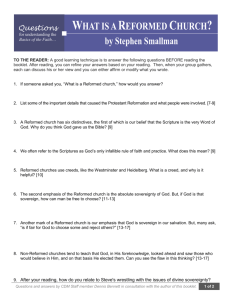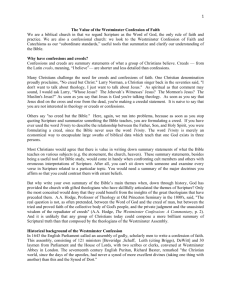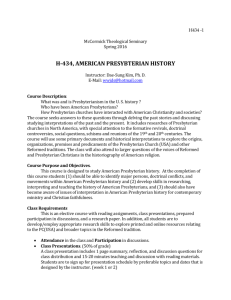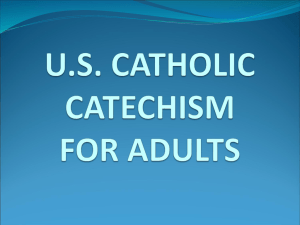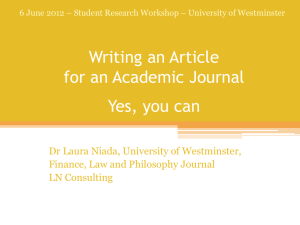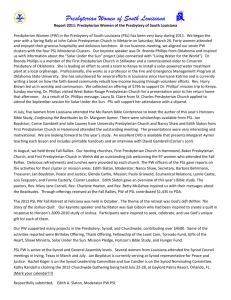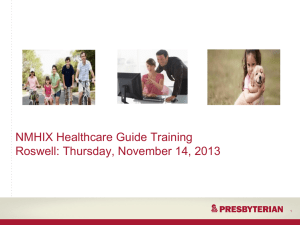Presbyterian Church - University of St. Thomas
advertisement
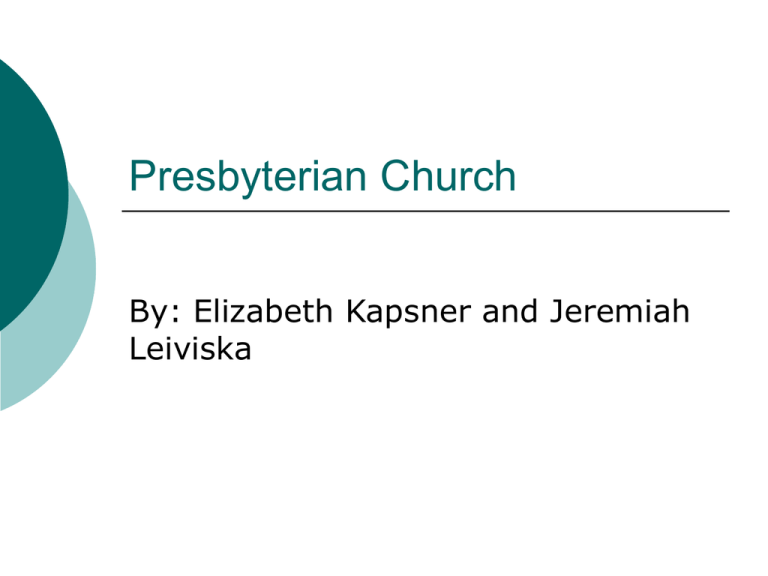
Presbyterian Church By: Elizabeth Kapsner and Jeremiah Leiviska Founder of Presbyterianism The Co-Founders of Presbyterianism were John Calvin and John Knox Calvinism, started by John Calvin, which was the start of the Presbyterian belief, although most denominations do not follow Calvinism anymore John Knox brought back Presbyterianism to Scotland in 1560 during the Reformation After Knox’s return, the Scottish Parliament adopted Presbyterianism in their government, along with Ireland and England in secret during the final years of Elizabeth I reign Continued Movement Return of the Monarchy was the return of Episcopalian belief Escaping persecution, Presbyterianism moved to the “New World” where Irish, English, Scottish, Dutch, German and French joined the smaller diverse branches into the Presbyterian Church (USA) in 1706 Beliefs of the Presbyterian Church Scripture alone is a fundamentalist stand on what the bible is, there are not a lot of traditions that are followed By Grace Alone means that by God’s grace alone we are saved To God alone be the glory is an understanding that only give the glory of your salvation to God and not to saints or mother Mary By Faith Alone means that our faith of God can only get people into heaven, Good works mean nothing Christ Alone, Christ has saved us Presbyterians Worldwide The Worldwide Presbyterian Church is in organization with Presbyterian Church (USA) The Worldwide Organization has ties with partner churches in 70 countries and missionaries in 80 other countries United States has 2.5 Million Presbyterians Korea has more than 4 Million Presbyterians Kenya has more than 3 million Presbyterians Indonesian Countries have more than 10 Million Based off of information from Rev. Fahed Abu-Akel, the highest elected Presbyterian official Book of Confessions The Book of Confessions was adopted by the Presbyterian Church (USA) as a way for people to know what the confession of their faith and bears witness to God’s grace in Jesus Christ The confessional statements in the Book of Confessions declare to its member and to the world: Who and what it is, What it believes, What it resolves to do These statements also: Guide the church and their study of the scriptures, summarize the essence of Christian tradition, direct the church in maintaining sound doctrines, equip the church for its work of proclamation Every confession is timely of the Christian faith and should not be changed but other should be added if more timely confessions are needed Table of Contents Nicene Creed (AD 325-381) Apostles’ Creed (Second to Sixth Century) Scots Confession (1560) Heidelberg Catechism (1563) Second Helvetia Confession (1566) Westminster Confession of Faith (1647) Westminster Shorter Catechism (1647) Westminster Larger Catechism (1647) The Theological Declaration of Barmen(1935) Confession of 1967 (1967) A brief Statement of Faith (1991) Westminster Denomination A larger portion of the Presbyterian Church believes in the Westminster denomination Westminster uses Catechism, which exist as larger and smaller Catechism The larger version is for the “more exact and comprehensive” member to be fully aware of their confessions. The shorter version was for “more easy and short” for the beginning member Example: Question 1: What is the chief and highest end of man? Answer: Man's chief and highest end is to glorify God, and fully to enjoy him forever. Westminster (Cont.) Larger Catechism has 196 questions and answers Shorter Catechism has 107 questions and answers All of the Catechism of the Westminster were written in 1643 to 1647 by Tour of the Church http://www.implex.net/metatags/wes tminster/promo.asx
